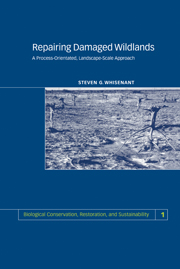Book contents
- Frontmatter
- Contents
- Preface
- Acknowledgments
- 1 Wildland degradation and repair
- 2 Assessing damage to primary processes
- 3 Repairing damaged primary processes
- 4 Directing vegetation change
- 5 Selecting plant materials
- 6 Site preparation and seedbed management
- 7 Planting
- 8 Planning repair programs for wildland landscapes
- Literature cited
- Index
6 - Site preparation and seedbed management
Published online by Cambridge University Press: 03 December 2009
- Frontmatter
- Contents
- Preface
- Acknowledgments
- 1 Wildland degradation and repair
- 2 Assessing damage to primary processes
- 3 Repairing damaged primary processes
- 4 Directing vegetation change
- 5 Selecting plant materials
- 6 Site preparation and seedbed management
- 7 Planting
- 8 Planning repair programs for wildland landscapes
- Literature cited
- Index
Summary
Introduction
Selectivly manipulating the seedbed environment is a powerful tool that influences the direction of repair efforts. We selectively modify the availability of safe sites to influence the direction of change. Welldesigned site preparation strategies increase certain species by creating safe sites that favor their establishment over unwanted species. Some site preparation techniques focus on improving equipment access to sites with heavy debris or vegetation.
Well-designed site preparation and seedbed management strategies consider the long-term implications of vegetative development on microenvironmental parameters. We can manipulate site and propagule availability by (1) doing nothing (unassisted natural recovery); (2) modifying seedbed conditions and relying on natural seed dispersal mechanisms (assisted natural recovery); or (3) selectively modifying seedbed conditions and adding carefully selected species mixtures (artificially induced recovery).
Unassisted natural recovery
Unassisted natural recovery is a passive strategy that requires neither seedbed preparation nor planting (Table 6.1). This strategy is attractive because it requires no management input. The direction and rate of natural recovery processes are restricted by (1) insufficient immigration of desired seed; (2) dominance by undesirable plants; and (3) excessive herbivore damage to developing plants. Careful evaluation of these potential interactions contributes to the development of appropriate recovery strategies. Chapter 4 contains additional discussions of natural recovery strategies.
Unassisted natural recovery operates slowly, with unpredictable results (Harmer & Kerr, 1995). It is unsatisfactory if repair objectives require the establishment of particular species groups within a particular time span. Colonization requires years to develop, particularly if it does not begin soon after disturbance.
- Type
- Chapter
- Information
- Repairing Damaged WildlandsA Process-Orientated, Landscape-Scale Approach, pp. 168 - 197Publisher: Cambridge University PressPrint publication year: 1999



